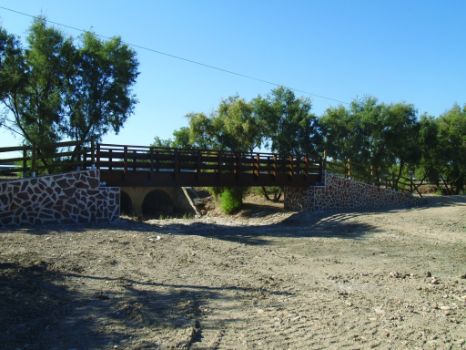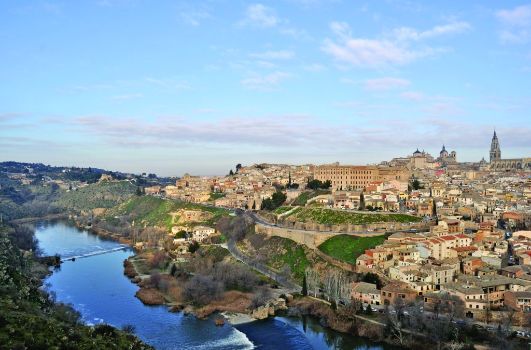Net of Natural
Trails

Stage 21: Villamejor - Toledo
Description
Escorting the River Tagus to the Imperial City of Toledo
This Stage escorts the River Tagus on its way back to Castile-La Mancha through the lands of Toledo, arriving at the impressive Imperial City via a river promenade with stunning views.
The route leaves Villamejor crossing the tracks on its way to the N-400. Further on, it changes direction, and continues towards a Stage specially adapted for this Nature Trail. This specially adapted route is closed to vehicle traffic with bollards, and runs parallel to the national road for about three kilometres. Wood and stone walkways have been built to enable easier crossing of rivers and streams, which run dry in summer.
A sign at the end of this Stage indicates the northbound route that the Trail takes to venture into a cropland equipped with a circular irrigation system. A hydraulic infrastructure of great importance to the area can be seen in this stretch. Another sign indicates that the Imperial City is 27 km away.
The Trail traverses through the ruins of ancient hydraulic systems and buildings used by day labourers in ancient times. The image is often rather melancholic. The Trail runs parallel to the N-400 for some time, until it arrives at a large roundabout at Algondor. Here is the old railway station that served as a transit point for trains running from Madrid to Toledo.

The route continues along livestock trails until it reaches another area with quarries; caution should be exercised again due to heavy vehicles and lorries. The large olive plantations are interrupted only by steep railroad embankments, which the route circumvents through a tunnel with panoramic views and the silhouette of Toledo.
The path crosses a river at Vereda del Rey, the last bridge before reaching the industrial buildings on the outskirts of Toledo. The first building to the right is a well-known ceramic factory. At the end of this building, the Trail crosses the N-400 again and enters Toledo through this industrial estate. The route runs along Jarama Street, and then continues along a large avenue popularly known in Toledo as the “Avenida del Tajo”. After several twists and turns, the route crosses the rail tracks again.
From here, the route leaves behind the paved roads and follows the meanders closest to Toledo. The Trail becomes a path that runs along the river during a few metres, with magnificent views of the flora and fauna that inhabit its banks. The route gradually approaches the Imperial City, following the course of the river, with frequent rest areas and shade to enjoy the scenery.

The views of the Alcázar and the cathedral from the river are spectacular. Crossing the new Alcántara Bridge at Paseo de la Rosa and Juanelo roundabout, the route draws closer to the buttresses on which the city is built. The path barely runs on paved roads. Indeed, from here, it turns left venturing onto the Route of Don Quixote. The spectacular suspension bridge over the cliffs located between the river and the city provides an exceptionally rewarding experience.
From here, the route reaches the Casa del Diamantero and the Paso del Barquero. Although the walk continues at lower heights, closer to the river and the rest areas and parks that dot its course, the beauty of the views remains undiminished. The endpoint of this Stage, between the bridges of San Martin and Cava, leads to the monumental area of the city via the Bajada de San Martín.
Sites of interest
Profile

Highlights
Further information
Toledo: World Heritage Site
Toledo was designated a UNESCO World Heritage Site in 1986. It is unique in that the three monotheistic religions and cultures -Muslim, Jewish and Christian- left their mark in the city.
The city offers plenty to explore from the architectural, cultural, artistic and gastronomical to routes of convents, churches, bridges and towers, artistic routes and, even, unknown heritage. It is possible to discover paintings by El Greco, Titian and Goya, admire mediaeval military architecture, or visit ancient Roman caves and Arab baths.
Baños de las tenerías
The Muslim water-related structures made of brick consist of several rooms whose roofs no longer exist.
Torre de San Cipriano
Located in the primitive church of San Cipriano, one of the oldest in Toledo, it is first mentioned in 1125, although it may have been first a mosque.
Roman vaults of Nuncio Viejo
The Roman baths and the cisterns of the water supply network located in the basement of the Tax Office are the two most important Roman remains of the city.
Gateways and Walls
Several interesting gateways can be found throughout the city, including the Puerta de Alfonso VI; the Renaissance Puerta de Bisagra, built in 1550; the Puerta del Vado, discovered in 2002, and the Mudejar Puerta del Sol, built in the 14th century.
Bridges and Towers
The city also boasts bridges and towers worth visiting, including the Puente de San Martin, a perfect example of medieval military architecture; the Puerta del Cambrón, in Renaissance-style but Arab origin; and the Torre de los Abades, built in Muslim times.
Both the Municipal Tourism Council and the City of Toledo Consortium organise free tours of the lesser-known monuments, archaeological sites and other attractions that have been recovered after many years, in some cases centuries.
Alternatively, it is possible to take a small "train" at the Plaza de Zocodover, in the city centre, to tour the city, including the traditional panoramic views from the Tagus Valley.




